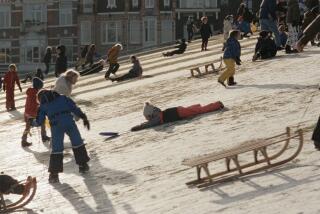A Friend Remembers Anne Frank
- Share via
HOUSTON — A tattered, 1938 first edition of the Dutch version of the board game Monopoly takes Jacqueline Sanders-van Maarsen Sanders back to a time before her best childhood friend, Anne Frank, became an icon of Holocaust history.
Van Maarsen, now 72, met Frank when the girls were 12-year-old students at a segregated Jewish school in Amsterdam. They shared competitive games of “Monopoly,” books and movie-star postcards in the year before Frank went into hiding, facing adolescence in a time of Nazi terror.
Van Maarsen, identified by her nickname “Jopie” in Frank’s famous diary, still lives in Amsterdam. She also still has the board game, books she shared with Frank, an original copy of a poem Frank wrote and two letters Frank wrote to her while in hiding.
Those artifacts were on exclusive display at the Holocaust Museum Houston through last week. It was the first time they were displayed in the United States.
“There’s nothing else left of our very close friendship,” said Van Maarsen, author of 1990’s “My Friend Anne Frank.” Van Maarsen is now a designer and book binder.
Van Maarsen was recently in Houston for the Main Street Youth Theater’s production of “The Diary of Anne Frank” with the artifacts in tow as a favor to friends at the museum.
The Frank display compliments a larger diary exhibit curator Amy Duk and author Alexandra Zapruder assembled that features original writings from eight teenage Holocaust survivors or victims.
“This looks beyond the writings of Anne Frank,” Duke said. “These pieces of paper survived a war. Some were found in abandoned apartments months after the war was over. We want to teach young people that it’s not just adults who make history.”
Van Maarsen said she met Frank as they rode bicycles home from school in October 1941. They studied and played together almost daily from then on. She said they sensed tension from their families who, like other adults, kept children largely unaware of the Nazi threat.
The girls agreed to write farewell letters to each other in case either “had to leave unexpectedly,” Van Maarsen said.
She last spoke to Frank the day before the Frank family went into hiding in July 1942, and her friend gave no indication of what was to come. Frank’s father, Otto--the family’s lone Holocaust survivor--gave Van Maarsen the letter from his daughter after he retrieved her writings after World War II.
“When you telephoned me on Sunday afternoon I couldn’t say anything, for my mother had told me not to,” Frank wrote to Van Maarsen. “The whole house was upside-down and the front door was locked. I can’t write to everyone, and that’s why I am writing to you only.”
“I did not know she was in hiding,” Van Maarsen said. “The family left an address in Switzerland, and I knew she had family there. So I felt Anne was safe.”
Van Maarsen’s father and paternal grandparents were killed during the war. But her mother, who wasn’t Jewish, managed to spare herself and her two daughters.
Van Maarsen said her friendship with Anne Frank extended to Otto Frank, who died in 1980, as he coped with losing his family in the years after the war.
“He felt close to Anne when he saw me,” she said.
Van Maarsen married another Holocaust survivor, Ruud Sanders, and kept her friendship with Anne Frank to herself to avoid capitalizing on Frank’s posthumous fame.
Decades later, Van Maarsen said she went public with the relationship, giving presentations at schools with her artifacts, after she noticed others who never met Frank or barely knew her claimed close friendships.
She said her friend has largely been portrayed accurately, in the play and film based on Frank’s diary.
Van Maarsen gave more praise to a 1998 book by Melissa Muller, “Anne Frank: The Biography,” and a May miniseries based on it, both of which explored Frank’s life before going into hiding and how she died in a typhus-plagued concentration camp a few weeks before it was liberated by British troops on April 15, 1945.
“I think it’s very important that she has become a symbol and that her diary is accessible to young people, so they can see what happens when racism is pushed to extremes,” Van Maarsen said.
More to Read
The biggest entertainment stories
Get our big stories about Hollywood, film, television, music, arts, culture and more right in your inbox as soon as they publish.
You may occasionally receive promotional content from the Los Angeles Times.










